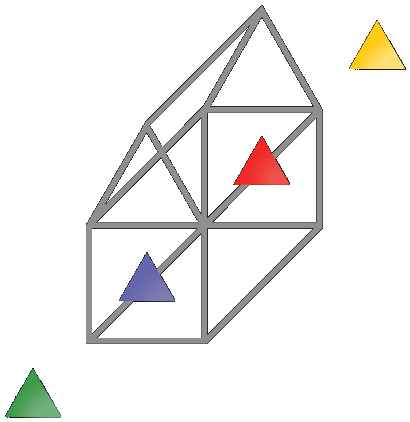Featured in STAINED GLASS, Spring 2018:
Stained Glass Association of America's quarterly journal
Architect: Bob Brotherton, AIA, Tucson, AZ
Liturgical Design Consultant: Ken Griesemer, Griesemer & Associates, Albuquerque
Glass Painting & Etching: Lisa Roberson, Rising Sun Gallery, Midland, TX
Reservation Chapel: Risen Christ Windows
3'-6 w by 7'-0 each - six total
Blessed Mother Chapel: St. Juan Diego Windows
3'-6 w by 7'-0 each - six total plus door & transom
The stained glass for Holy Cross Retreat Center’s new Chapel appeared just in time for its 60th Anniversary celebrations. The focus of worship in the Chapel is a huge hand-hewn Altar Cross. The Reservation and Blessed Mother Chapels flanking the Altar contain the 12 windows, door and transom where the stained glass resides.
CIRCLES: Circles are traditional symbols of perfection. The many round-topped windows and doorways in this new Chapel echo portico and atrium arches in the retreat center’s first building which was dedicated 60 years earlier (see HCRC history). Circular flourishes within the stained glass resonate within these arched windows. The partial circular arcs in the stained glass remind us of our inability to fully comprehend God’s perfection as symbolized by a complete circle.
LIGHT IN THE DARKNESS: On a larger scale, the spiritual “light” that radiates from the 14′ Altar Cross reappears as ripples and linework spreading across the stained glass in both side chapels. Similarly, normally horizontal “saddle bars” that connect individual stained glass panels within each window appear to radiate diagonally from the Altar Cross. These elements symbolize God’s Word spreading out in to the world; the presence of the Holy Spirit; and the love of Christ. Conversely, they also trace our prayers and supplications flowing up to God.
The stained glass for the two side chapels acknowledges their orientation. The South-facing Reservation Chapel’s bright and airy glass palette enhances views out into the Rosary Walk garden and to pecan orchards and mountains beyond. The North facing Blessed Mother Chapel’s stained glass contains deeper color befitting the Holy Mother’s appearances to Juan Diego in the cold, dark of Mexican winter. This palette also limits views out to the adjacent parking area.
The Reservation Chapel’s stained glass includes a sometimes blindingly radiant, risen Christ that greets worshipers with a Eucharistic loaf of bread and welcoming hand. Much as the newly resurrected Christ was often not immediately recognized, the brilliant opal glass of Christ can be seen as soon as one enters the Nave, but his subtly etched visage is only revealed upon close inspection. The circular halo or aura that radiates from Christ, symbolically ripples across the stained glass and out into the world. Completing the symbolism of the Loaves and Fishes, cool waters and fish flow and swim out from Christ. Some even reappear in the Blessed Mother Chapel stained glass.
The stained glass in the Blessed Mother Chapel resonates with the image Our Lady of Guadalupe hanging on its opposite wall. The stained glass depicts the miraculous origin of this revered portrait which was imprinted by miraculous wintertime roses onto Juan Diego’s tilma (cloak). Roses spill from his cloak and waft across the windows (a few reappear in the Reservation Chapel) as reminders of the Holy Mother leading us to both Christ and the Eucharist.
St. Juan Diego’s stained glass aura also ripples across the stained glass. The portrait of Juan Diego is painted on the glass – a more “grounded” feel than the more ephemeral feel of the etched Christ portrait. Together with rich, darker reds and other deep colors, this reminds us of our fleeting corporal time on Earth as compared with the brighter airiness of the more spiritual plane depicted in the Reservation Chapel windows. The more deeply saturated color surrounding Juan Diego brightens on the Altar/right side as color shifts from darker purples, blues and greens into lighter reds, ambers and yellows. This triumph of “light over darkness” serves as counterpoint to the fully “enlightened” brighter color in the Reservation Chapel.
BORDERS: Because the Chapel windows are approached from an angle, their stained glass borders accentuate this perspective. Windows in the left wall of each chapel are seen from the left, so their borders are widened on the right. Likewise, windows in the right-hand walls are viewed from the right and their borders are emphasized on the left.
THE GLASS: Over 67 colors of glass comprise the main glass palette along with many additional accent colors. The European mouthblown glass is primarily from Germany and Poland with a smattering from France. Austrian Lead-Crystal Prisms are sprinkled across the stained glass – their tiny rainbows symbolize hopefulness and God’s unexpected gifts. German cast-glass jewels can be seen in the centers of the roses and eyes of the fish.
PROCESS: The “Process” photos document some of the steps in the making of the Windows for Holy Cross.
COMMENTS:
LITURGICAL ART TEAM:
• Margarito Mondragon, Las Vegas, NM: Statues/Bultos
• Virginia Maria Romero, New Mexico: Stations of the Cross
• Kat Dube, Mesilla Park: Rosary Walk & Labyrinth
• Ken Griesemer, Albuquerque: Altar Furniture and the Cross
A special THANK YOU! to Carl McGrew and his Good Works Volunteers for preparing the chapels for the arrival of the stained glass and their assistance throughout its installation!
Materials: European mouthblown glass, Austrian lead-crystal prisms, lead, solder
